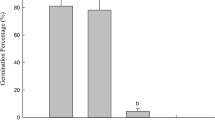Summary
The application of chlorine from the very beginning of the life-cycle of wheat, brings about a slight depression in dry matter production and an increase in moisture content during their early stages of growth. With advance in age, however, the dry matter accumulation is markedly increased without any appreciable increase in water content.
Plants supplied with chlorine twenty days after germination have the maximum dry matter yield. Relative growth rate as well as net assimilation rate are also accelerated.
The treated plants do not show any marked effect on their shoot length although the assimilatory surface is increased beyond the control. The roots, on the other hand, in spite of a diminution in length, exhibit a greater lateral ramification and dry matter production.
Chlorine-treated plants have a larger percentage ear formation maximum values being obtained in case where this element is supplied twenty days after germination.
The accumulation of carbohydrates as also the diastatic activity are greater in the treated plants as compared to the control ones.
Growth of plants at successive stages of the life-cycle appears to be determined by both the age and the factor for chlorine a change in either bringing about a variation in dry matter production.
The greatest physiological need and hence the maximum augmentative efficiency of this element is found at the period (twenty days after germination in the present case) when plants are showing active growth and differentiation.
Similar content being viewed by others
Literature Cited
Breazeale, J. F.Jour. Agr. Bes., 1916,7, 407–416.
Bruns, A.Bot. Arch., 1925,11, 40–103.
Hawkins, L. A.Bot. Gaz., 1913,55, 265–285.
Hendry, G.W.Jour. Amer. Soc. Agron., 1918,10, 246–250.
Johnston, E. S.Johns Hopkins Univ. Cire., N.S., 1917,3, 211–217.
Kellerman, K. F.Bull. Torrey Bot. Club, 1903,30, 56–70.
Lane, J. H., and Eynon, L.Jour. Soc. Chem. Industry, 1923, p. 32 T.
Leydhecker, A.Landw. Versuchs-Stat., 1886,8, 177–187.
Link, K. P., and Tottingham, W. E.Jour. of American Chemical Soci., 1923,45.
Lomanitz, S.Soil Science, 1923,16, 183–195.
—, 1924,18, 353–371.
Loomis, W. E., and Shull, C. A.Methods in Plant Physiology, McGraw-Hill Publishing Book Company, Inc. New York and London, 1937.
Lundegardh, H.Jahrb. Wiss. Bot., 1914,53, 421–463.
Rudolfs, W.Soil Science, 1919,8, 397–427.
Singh, B. N., and Kumar, K.Proc. Ind. Acad.Sci., 1935,1, 754–762.
—, and Prasad, S.Ind. Jour. Agr.Sci., 1936,6, 720–745.
Skinner, W. W.Official and Tentative Methods of Analysis, Association of Official Agricultural Chemists, Washington, D.C., 1930.
Tottingham, W. E.Science, N.S., 1915, 42–68.
—Johns Hopkins Univ. Circ., N.S., 1917,3, 217–221.
—Jour. Amer. Soc. Agron., 1919,11, 1–33.
Trelease, S. F.Johns Hopkins Univ.Circ., N.S., 1917,3, 222–225.
—Philippine Jour. Sci., 1920,17, 527–003.
Author information
Authors and Affiliations
Rights and permissions
About this article
Cite this article
Singh, B.N., Prasad, S. The effect of chlorine in relation to age upon the growth and composition of wheat. Proc. Indian Acad. Sci. 8, 324–335 (1938). https://doi.org/10.1007/BF03048222
Received:
Issue Date:
DOI: https://doi.org/10.1007/BF03048222




